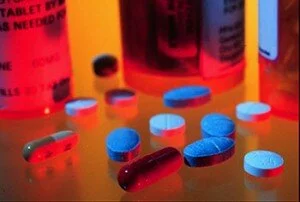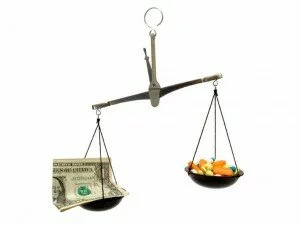Medications are often cheap for people with insurance, but the average cost of prescription drugs without insurance can be expensive. Fortunately, it’s still possible to save on the cost of medicine in this situation. For example, assistance plans are available through certain pharmaceutical companies to cover part of the price of their prescription drugs. In addition, some retailers offer savings programs that let users buy generic drugs at discount prices far below the cost of name-brand versions.
Standard Pill Costs
Unfortunately, it’s difficult for consumers to calculate costs of prescription drugs for budget purposes. Because drugs vary in strength and prescriptions come in different sizes, prices vary considerably. Because generic drugs aren’t available at all pharmacies, patients can’t always expect to find the cheapest versions of medicines they need. Lipitor is one example of this. For the 10 mg version of the drug, U.S. consumers can expect to pay anywhere from $0.43 to $1.99 for a single pill. By comparison, the 80 mg pill of the same medication costs between $0.72 and $3.36 for a pill, which makes it considerably cheaper when patients have the option to purchase 60 or 90 days worth of the drug.
Prohibitive Pricing
The average cost of prescription drugs without insurance is too high for many patients. Lyrica is one example with its average price of $3 per pill. Meanwhile, the acid reflux drug Nexium can cost anywhere from $0.61 up to $3.64 for the 40 mg pills. Consumers can expect to see significantly higher prices for name-brand versions of drugs. In cases of inhaled or injected medications, prices are often even higher. Humira, for instance, can cost as much as $1,890 for just two syringes without insurance to cover it.
Big-Box Retailers: Target and Walmart
Patients can find literally hundreds of generic drugs for as little as $4 per month at these stores, with 90-day supplies going for just $10. Unfortunately, these prices cover only a limited selection of drugs, making the average cost of prescription drugs without insurance too high for many consumers. For example, new drugs without generic versions aren’t sold at these low prices. However, this discount pricing often does cover drugs used for common health problems such as high blood pressure, diabetes and high cholesterol. Both Walmart and Target offer similar pricing on these medications. Patients can usually find these drugs for low prices by shopping around.
How Patients Can Save Money
The average cost of prescription drugs without insurance can be high, but patients can save quite a bit of money if they know how. Opting for the generic brand of a drug, if available, is a sure way to save money every time. In some cases, drug manufacturers list discount plans, coupons and other forms of assistance on their websites. Physicians are also occasionally valuable sources of both samples and information about finding discount drugs and free trials. However, eDrugSearch.com is definitely the best way to compare prices between different sources and ultimately get safe access to affordable medications. The average consumer who uses eDrugSearch.com to compare their prices from licensed online pharmacies will save 72% off standard U.S. retail prices.
About this Angie’s List Expert: Cary Byrd is the president and founder of eDrugSearch.com. Based in San Antonio, eDrugSearch.com is a free cost comparison engine that helps consumers get safe access to affordable medications and advocates licensed online pharmacies as a widely accepted alternative.

Dr. Sanjay Gupta recently sat in for Larry King and had former president Bill Clinton as his guest. Clinton had some interesting things to say about the problem of high drug costs — driving home the point that our current system of corporate welfare for Big Pharma just isn’t working.
Here are some excerpts of Clinton’s remarks, which I’ve organized by talking point:
Americans Pay More for Less
The McKenzie Study done a couple of years ago said that we pay $66 billion a year more for medicine and that at least our older populations consume relatively less per capita than other wealthy countries.
Our Government Is Subsidizing Big Pharma
We have made a bargain with our pharmaceutical companies. We’ve said to them for decades now, we love having you in America. We’re proud of you. We know you have to spend a lot of money on research and then you market the drugs and all. So we will eat your research and development costs in American prices so that you can sell exactly the same drugs you sell to us for less money in Canada and Europe … Keep in mind, Europe has a lot of very successful drug companies and they don’t do this.
This Subsidization Does Not Help Americans
So how can we reach a different arrangement so that we keep the drug companies healthy enough and we keep them developing new medicine? The system we’ve got is not working very well. They don’t have a lot of new medicines in the pipeline … Meanwhile, we keep eating all these costs and countries just as wealthy as we are, are getting the same drugs made by the same people for less money, which is why there was so much opposition to allowing re-importation from Canada. The one good place to start is what President Obama has proposed, letting the federal government bargain [with pharmaceutical companies].
Big Pharma’s Profits Have Been 3x Greater Than Wal-Mart’s
For most of the 1990s and the early part of this decade, they earned 18 percent, which is a huge return. You know, Wal- Mart is, what, 5 or 6 percent. And it is fascinating to see that at the same time … the number of new drugs in the pipeline seems to be slowing down. So we need to examine both how we can both get the benefits of [medical] advances and how we can lower the cost to the consumers.
Clinton is right. Corporate welfare is not helping America; it’s only helping Big Pharma’s shareholders. We need to alter our course — and do it now.
As anticipated, bills to finally legalize the purchase of Canadian drugs by U.S. consumers were introduced in both houses of Congress this week.
Here’s a news release excerpt on the Senate bill:
U.S. Senators Byron Dorgan (D-ND), Olympia Snowe (R-ME), John McCain (R-AZ), and Debbie Stabenow (D-MI) introduced critical drug importation legislation today that will reduce the cost of prescription drugs in the United States. The Senators said their legislation, the “Pharmaceutical Market Access and Drug Safety Act,” will bring consumers immediate relief and will ultimately force the pharmaceutical industry to lower drug prices in the United States.
The Congressional Budget Office estimates the bill would save American consumers $50 billion over the next decade, including more than $10 billion in federal government savings.
The bill allows U.S.-licensed pharmacies and drug wholesalers to import FDA-approved medications from Canada, Europe, Australia, New Zealand and Japan and pass along the savings to American customers. This approach will allow Americans to benefit from prices in these countries, which are 35 to 55 percent lower than in the U.S., while still enabling consumers to receive medications at a local pharmacy. The legislation would also allow individual consumers to purchase prescription drugs for personal use from safe, reliable, FDA-inspected Canadian pharmacies…
“As Americans struggle with increasing health care costs during the deepest recession since World War II, more and more individuals are forced to skip doses or split pills, neglecting their health needs to keep food on the table,” said Senator Snowe, a member of the Health Subcommittee. “By implementing a safe prescription drug importation program, we will increase competition within the domestic prescription drug market which, in turn, will ensure more Americans have access to safe and affordable medications.”…
“For far too long Americans have seen health care costs, especially prescription drug costs increase year after year,” said Senator John McCain. “Re-importation legislation would allow access to safe and effective prescription drugs at much lower prices than are available in the United States. If enacted, the legislation will provide the much needed relief to American families, especially seniors and others on fixed incomes, who are facing tough economic times.”
And here’s a news report excerpt on the House version of the bill:
As more Americans find themselves struggling to pay for their prescription drugs, United States Representatives Marion Berry (D-AR) and Jo Ann Emerson (R-MO) introduced a bill Wednesday to help lower the costs of pharmaceuticals for consumers.
“The high cost of prescription drugs reduces access to life-saving medications, particularly for the millions of individuals who lack prescription drug coverage,” said Berry. “Prescription drugs can be imported safely and effectively into the U.S. while at the same time providing significant savings to consumers. This bill will help individuals get the medicines they need by lowering costs and ensuring the integrity of our safety standards are met.”
“The unnatural barriers to competition on prescription drug costs prevent the appropriate medicines and the appropriate doses from going to the Americans who need their prescriptions filled as part of their doctor’s treatment. Furthermore, during a time when millions of American families are making cuts to their budgets and retirees have lost substantial amounts of their life savings in the market, we should be working especially diligently to find safe ways to reduce the costs of medicines. This is a straightforward proposal with bipartisan support in Congress, and now is the time to take up this measure,” said Emerson.
Hallelujah.
 In a Saturday blog post, Julie Deardorff of the Chicago Tribune published six money-saving drug tips from Stefanie Ferreri and Jena Ivey, pharmacists and assistant professors at the University of North Carolina. It’s nothing you haven’t read here before, but I’m a firm believer in education through repetition and reinforcement. The tips –
In a Saturday blog post, Julie Deardorff of the Chicago Tribune published six money-saving drug tips from Stefanie Ferreri and Jena Ivey, pharmacists and assistant professors at the University of North Carolina. It’s nothing you haven’t read here before, but I’m a firm believer in education through repetition and reinforcement. The tips –
1. Eliminate medicines you don’t need or that don’t work.
2. Don’t be shy about asking for cheaper options.
3. Shop around.
4. Time it right (i.e., buy more pills at once to lower the cost per dose).
5. Don’t “ask your doctor” for advertised drugs and skip the samples.
6. Literally cut costs (i.e., cut pills in two if the pill can be safely split).
We have a different view about free drug samples, but otherwise the Tribune’s advice is solid. Read the full article here.
The Orange County Register is asking its readers what strategies they use to keep drug expenditures down:
“The soaring costs of prescription drugs have led some health plans to require mail-order prescriptions or limit what medications are covered. The Register wants to hear how readers have coped with changes to their prescription drug benefits and escalating costs. Have you found creative ways to save costs? Have you skipped a medication against doctor’s orders? Do you ration your pills so your supply lasts longer?”
We encourage you to tell your story to Register health reporter Courtney Perkes at .
This video report from the Associated Press is truly disturbing, telling the story of a family forced to declare bankruptcy because of the high prescription drug costs of treating their son’s autism. The family had health insurance, too — but it wasn’t enough to cover the child’s exorbitant treatment and drug costs.
Watch it:
And remember to always use eDrugSearch.com to freely compare prescription drug prices to ensure you get safe access to affordable medications, guaranteed.
-
 Subscribe in a reader
Subscribe in a reader -
Search Blog Posts
-
Ads

-
-
How to Safely Buy Prescription Drugs Online from Cary Byrd on Vimeo.
-
Medi-Share: Christian Health Insurance Alternative

-
Archives
-
Our Healthcare100 Ranking
-
Tags
adverse drug reactions big pharma buy drugs online Canadian drugs canadian pharmacies canadian pharmacy compare drug prices consumer reports divine healing Drug costs Drug interactions Drug Prices drug safety tips drug savings tips dtc advertising eDrugSearch.com FDA healing scriptures Health 2.0 healthcare100 Healthcare blogs high drug costs high drug prices Jehova Rophe Jesus Christ licensed Canadian pharmacies licensed online pharmacies Lipitor mail order pharmacies medicare coverage gap medicare doughnut hole Medi Share miracles online pharmacies online pharmacy safety personal drug importation pharmacy spam prescription drug abuse Prescription drugs reimportation rogue online pharmacies save money on prescriptions The Great Physician The Lord our Healer Wal-Mart $4 generic drug program

